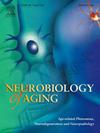Circulating non-esterified fatty acids, risk of dementia and cognitive decline: The cardiovascular health study and multi-ethnic study of atherosclerosis
IF 3.7
3区 医学
Q2 GERIATRICS & GERONTOLOGY
引用次数: 0
Abstract
Circulating non-esterified fatty acids (NEFAs) have toxic effects on a variety of organs central to cardiometabolic disease and can cross the blood-brain barrier. Whether NEFAs associate with cognitive decline or dementia remains unknown. Circulating total NEFA levels were measured in 3242 participants without dementia among older adults of the Cardiovascular Health Study (CHS) and related to adjudicated dementia over 6 years (n = 456 cases) and annually assessed cognitive decline. For confirmation, we related circulating NEFAs to cognition assessed 10 years later among 4361 participants in the Multi-Ethnic Study of Atherosclerosis (MESA). In CHS participants, each SD higher NEFA levels were associated with a hazard ratio (HR) for all-cause dementia of 1.11 (95 % CI: 1.01; 1.22). Baseline NEFA levels were also associated with more rapid decline in cognition over 6 years of follow-up. In MESA, circulating NEFA measurements were associated with lower cognitive scores measured 10 years later.’
求助全文
约1分钟内获得全文
求助全文
来源期刊

Neurobiology of Aging
医学-老年医学
CiteScore
8.40
自引率
2.40%
发文量
225
审稿时长
67 days
期刊介绍:
Neurobiology of Aging publishes the results of studies in behavior, biochemistry, cell biology, endocrinology, molecular biology, morphology, neurology, neuropathology, pharmacology, physiology and protein chemistry in which the primary emphasis involves mechanisms of nervous system changes with age or diseases associated with age. Reviews and primary research articles are included, occasionally accompanied by open peer commentary. Letters to the Editor and brief communications are also acceptable. Brief reports of highly time-sensitive material are usually treated as rapid communications in which case editorial review is completed within six weeks and publication scheduled for the next available issue.
 求助内容:
求助内容: 应助结果提醒方式:
应助结果提醒方式:


